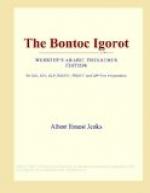During the entire game, lasting a full half hour or until night settled on them or a mother came to take home one of the little, romping, wild things — just as the American child is called from her games to an early bed — peal after peal of the heartiest, sweetest laughter rang a constant chorus. The boys have at least two systematic games. One is fug-fug-to’, in imitation of a ceremonial of the men after each annual rice harvest. The game is a combat with rocks, and is played sometimes by thirty or forty boys, sometimes by a much smaller number. The game is a contest — usually between Bontoc and Samoki — with the broad, gravelly river bed as the battle ground. There they charge and retreat as one side gains or loses ground; the rocks fly fast and straight, and are sometimes warded off by small basket-work shields shaped like the wooden ones of war. They sometimes play for an hour and a half at a time, and I have not yet seen them play when one side was not routed and driven home on the run amid the shouts of the victors.
The other game is kag-kag-tin’. It is also a game of combat and of opposing sides, but it is not so dangerous as the other and there are no bruises resulting. Some half-dozen or a dozen boys play kag-kag-tin’ charging and retreating, fighting with the bare feet. The naked foot necessitates a different kick than the one shod with a rigid leather shoe; the stroke from an unshod foot is more like a blow from the fist shot out from the shoulder. The foot lands flat and at the side of or behind the kicker, and the blow is aimed at the trunk or head — it usually lands higher than the hips. This game in a combat between individuals of the opposing sides, though two often attack a single opponent until he is rescued by a companion. The game is over when the retreating side no longer advances to the combat.
The boys are constantly throwing reed spears, and they are fairly expert spearmen several years before they have a steel-bladed spear of their own. Frequently they roll the spherical grape fruit and throw their reeds at the fruit as it passes.
Here, there, and everywhere, singly or in groups, boys perform the Igorot dance step. A tin can in a boy’s hands is irresistibly beaten in rhythmic time, and the dance as surely follows the peculiar rhythmic beating as the beating follows the possession of the can. As the boys come stringing home at night from watching the palay fields, they come dancing, rhythmically beating a can, or two sticks, or their dinner basket, or beating time in the air — as though they held a gangsa[18]. The dance is in them, and they amuse themselves with it constantly.
Both boys and girls are much in the river, where they swim and dive with great frolic.
During the months of January and February, 1903, when there was much wind, the boys were daily flying kites, but it is a pastime borrowed of the Ilokano in the pueblo. Now and then a little fellow may be seen with a small, very rude bow and arrow, which also is borrowed from the Ilokano since the arrival of the Spaniard.




